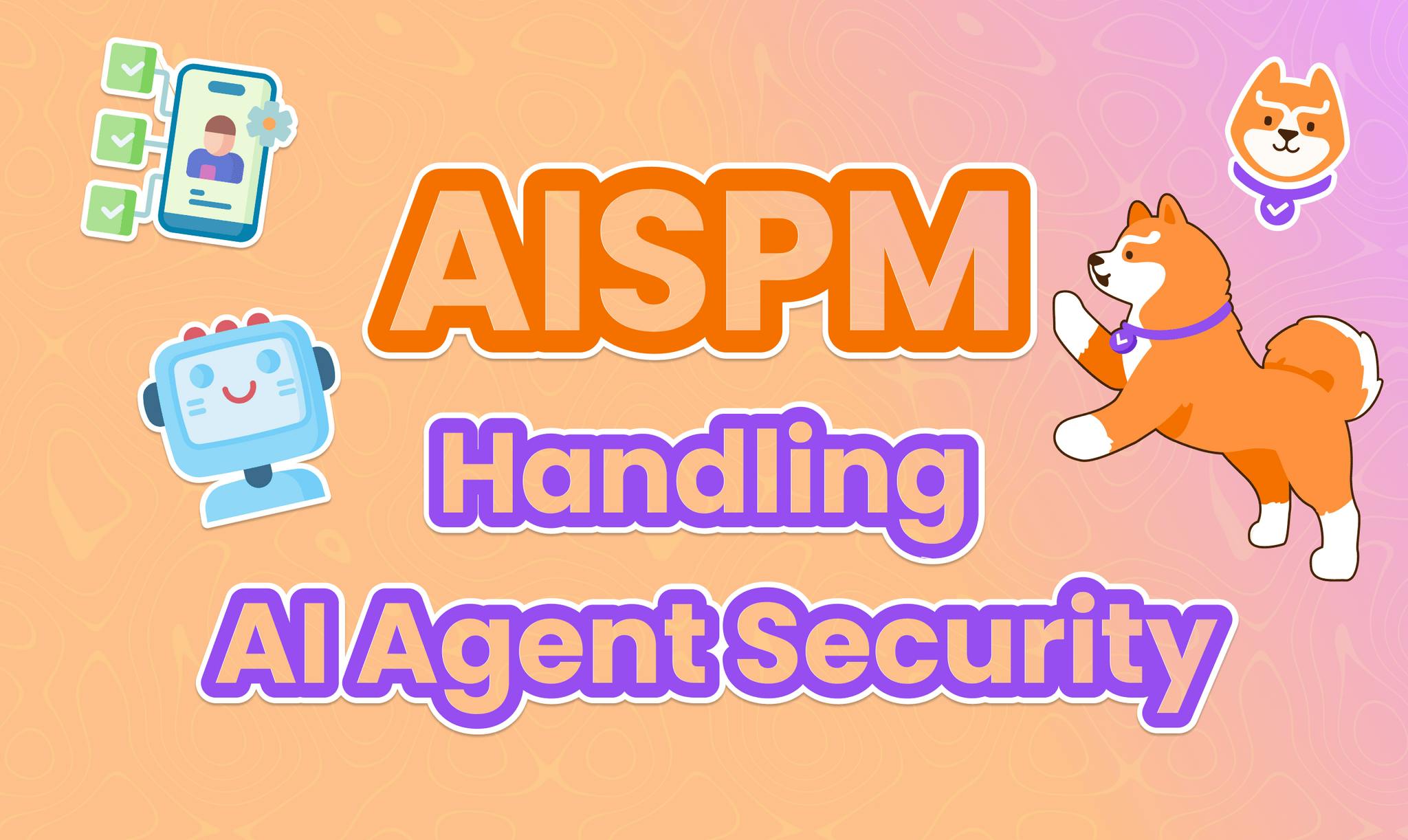AI Demands a New Security Posture
AI Security Posture Management (AISPM) is an emerging discipline focused on securing AI agents, their memory, external interactions, and behavior in real-time.
As AI agents become deeply embedded in applications, traditional security models aren’t really up for the task. Unlike static systems, AI-driven environments introduce entirely new risks—hallucinated outputs, prompt injections, autonomous actions, and cascading interactions between agents.
These aren’t just extensions of existing problems—they’re entirely new challenges that legacy security posture tools like DSPM (Data Security Posture Management) or CSPM (Cloud Security Posture Management) were never designed to solve.
AISPM exists because AI systems don’t just store or transmit data—they generate new content, make decisions, and trigger real-world actions. Securing these systems requires rethinking how we monitor, enforce, and audit security, not at the infrastructure level, but at the level of AI reasoning and behavior.
If you’re looking for a deeper dive into what machine identities are and how AI agents fit into modern access control models, we cover that extensively in “What is a Machine Identity? Understanding AI Access Control”. This article, however, focuses on the next layer: securing how AI agents operate, not just who they are.
Join us as we explain what makes AISPM a distinct and necessary evolution, explore the four unique perimeters of AI security, and outline how organizations can start adapting their security posture for an AI-driven world.
Because the risks AI introduces are already here, and they’re growing fast.
What Makes AI Security Unique?
Securing AI systems isn’t just about adapting existing tools—it’s about confronting entirely new risk categories that didn’t exist up to now.
As mentioned above, AI agents don’t just execute code—they generate content, make decisions, and interact with other systems in unpredictable ways. That unpredictability introduces vulnerabilities that security teams are only beginning to understand.
AI hallucinations, for example—false or fabricated outputs—aren’t just inconvenient; they can corrupt data, expose sensitive information, or even trigger unsafe actions if not caught.
Combine that with the growing use of retrieval-augmented generation (RAG) pipelines, where AI systems pull information from vast memory stores, and the attack surface expands dramatically.
Beyond data risks, AI systems are uniquely susceptible to prompt injection attacks, where malicious actors craft inputs designed to hijack the AI’s behavior. Think of it as the SQL injection problem, but harder to detect and even harder to contain, as it operates within natural language.
Perhaps the most challenging part of this is that AI agents don’t operate in isolation. They trigger actions, call external APIs, and sometimes interact with other AI agents, creating complex, cascading chains of behavior that are difficult to predict, control, or audit.
Traditional security posture tools were never designed for this level of autonomy and dynamic behavior. That’s why AISPM is not DSPM or CSPM for AI—it’s a new model entirely, focused on securing AI behavior and decision-making.
The Four Access Control Perimeters of AI Agents
Securing AI systems isn’t just about managing access to models—it requires controlling the entire flow of information and decisions as AI agents operate. From what they’re fed, to what they retrieve, to how they act, and what they output, each phase introduces unique risks.
As with any complex system, access control becomes an attack surface amplified in the context of AI. That’s why a complete AISPM strategy should consider these four distinct perimeters—each acting as a checkpoint for potential vulnerabilities:
1. Prompt Filtering — Controlling What Enters the AI
Every AI interaction starts with a prompt, and prompts are now an attack surface. Whether from users, other systems, or upstream AI agents, unfiltered prompts can lead to manipulation, unintended behaviors, or AI “jailbreaks”.
Prompt filtering ensures that only validated, authorized inputs reach the model. This includes:
- Blocking malicious inputs designed to trigger unsafe behavior
- Enforcing prompt-level policies based on roles, permissions, or user context
- Dynamically validating inputs before execution
For example, restricting certain prompt types for non-admin users or requiring additional checks for prompts containing sensitive operations like database queries or financial transactions.
2. RAG Data Protection — Securing AI Memory and Knowledge Retrieval
Retrieval-Augmented Generation (RAG) pipelines—where AI agents pull data from external knowledge bases or vector databases—add a powerful capability but also expand the attack surface. AISPM must control:
- Who or what can access specific data sources
- What data is retrieved based on real-time access policies
- Post-retrieval filtering to remove sensitive information before it reaches the model
Without this perimeter, AI agents risk retrieving and leaking sensitive data or training themselves on information they shouldn’t have accessed in the first place.
“Building AI Applications with Enterprise-Grade Security Using RAG and FGA” provides a practical example of RAG data protection for healthcare.
3. Secure External Access — Governing AI Actions Beyond the Model
AI agents aren’t confined to internal reasoning. Increasingly, they act—triggering API calls, executing transactions, modifying records, or chaining tasks across systems.
AISPM must enforce strict controls over these external actions:
- Define exactly what operations each AI agent is authorized to perform
- Track “on behalf of” chains to maintain accountability for actions initiated by users but executed by agents
- Insert human approval steps where needed, especially for high-risk actions like purchases or data modifications
This prevents AI agents from acting outside of their intended scope or creating unintended downstream effects.
4. Response Enforcement — Monitoring What AI Outputs
Even if all inputs and actions are tightly controlled, AI responses themselves can still create risk, hallucinating facts, exposing sensitive information, or producing inappropriate content.
Response enforcement means:
- Scanning outputs for compliance, sensitivity, and appropriateness before delivering them
- Applying role-based output filters so that only authorized users see certain information
- Ensuring AI doesn’t unintentionally leak internal knowledge, credentials, or PII in its final response
In AI systems, output is not just information—it’s the final, visible action. Securing it is non-negotiable.
Why These Perimeters Matter
Together, these four perimeters form the foundation of AISPM. They ensure that every stage of the AI’s operation is monitored, governed, and secured—from input to output, from memory access to real-world action.
Treating AI security as an end-to-end flow—not just a static model check—is what sets AISPM apart from legacy posture management. Because when AI agents reason, act, and interact dynamically, security must follow them every step of the way.
Best Practices for Effective AISPM
As we can already see, securing AI systems demands a different mindset—one that treats AI reasoning and behavior as part of the attack surface, not just the infrastructure it runs on. AISPM is built on a few key principles designed to meet this challenge:
Intrinsic Security — Guardrails Inside the AI Flow
Effective AI security can’t be bolted on. It must be baked into the AI’s decision-making loop—filtering prompts, restricting memory access, validating external calls, and scanning responses in real-time. External wrappers like firewalls or static code scans don’t protect against AI agents reasoning their way into unintended actions.
The AI itself must operate inside secure boundaries.
Continuous Monitoring — Real-Time Risk Assessment
AI decisions happen in real-time, which means continuous evaluation is critical.
AISPM systems must track agent behavior as it unfolds, recalculate risk based on new context or inputs, and adjust permissions or trigger interventions mid-execution if necessary.
Static posture reviews or periodic audits will not catch issues as they emerge. AI security is a live problem, so your posture management must be live, too.
Chain of Custody and Auditing
AI agents have the ability to chain actions—call APIs, trigger other agents, or interact with users—these all require extremely granular auditing.
AISPM must:
- Record what action was performed
- Who or what triggered it
- Preserve the full “on-behalf-of” trail back to the human or system that originated the action.
This is the only way to maintain accountability and traceability when AI agents act autonomously.
Delegation Boundaries and Trust TTLs
AI systems don’t just act—they delegate tasks to other agents, services, or APIs. Without proper boundaries, trust can cascade unchecked, creating risks of uncontrolled AI-to-AI interactions.
AISPM should enforce strict scoping of delegated authority, Time-to-live (TTL) on trust or delegated access, preventing long-lived permission chains that become impossible to revoke, and enabling human review checkpoints for high-risk delegations.
Cryptographic Validation Between AI Agents
Lastly, as AI ecosystems grow, agents will need to trust—but verify—other agents’ claims. AISPM should prepare for this future by supporting cryptographic signatures on AI requests and responses as well as tamper-proof logs that allow agents—and humans—to verify the source and integrity of any action in the chain.
This is how AI systems will eventually audit and regulate themselves, especially in multi-agent environments.
While AISPM is still an emerging discipline, we’re starting to see practical tools and frameworks that help put its principles into action, enabling developers to build AI systems with security guardrails baked into the flow of AI decisions and actions.
AI Framework Integrations for Access Control
Popular AI development frameworks like LangChain and LangFlow are beginning to support integrations that add identity verification and fine-grained policy enforcement directly into AI workflows. These integrations allow developers to:
- Authenticate AI agents using identity tokens before allowing actions
- Insert dynamic permission checks mid-workflow to stop unauthorized data access or unsafe operations
- Apply fine-grained authorization to Retrieval-Augmented Generation (RAG) pipelines, filtering what the AI can retrieve based on real-time user or agent permissions.
These capabilities move beyond basic input validation, enabling secure, identity-aware pipelines in which AI agents must prove what they’re allowed to do at every critical step.
Secure Data Validation and Structured Access
Frameworks designed for AI application development increasingly support structured data validation and access control enforcement. By combining input validation with authorization layers, developers can:
This helps protect systems against accidental data leaks and intentional prompt manipulation by ensuring the AI operates strictly within its defined boundaries.
Standardizing Secure AI-to-System Interactions
Emerging standards like the Model Context Protocol (MCP) propose structured ways for AI agents to interact with external tools, APIs, and systems. These protocols enable:
- Explicit permission checks before AI agents can trigger external operations
- Machine identity assignment to AI agents, scoping their capabilities
- Real-time authorization rules at interaction points, ensuring actions remain controlled and traceable
This is crucial for keeping AI-driven actions—like API calls, database queries, or financial transactions—accountable and auditable.
Looking Ahead: The Future of AISPM
The rapid evolution of AI agents is already pushing the boundaries of what traditional security models can handle. As AI systems grow more autonomous—capable of reasoning, chaining actions, and interacting with other agents—AISPM will become foundational, not optional.
One major shift on the horizon is the rise of risk scoring and trust propagation models for AI agents. Just as human users are assigned trust levels based on behavior and context, AI agents will need dynamic trust scores that influence what they’re allowed to access or trigger—especially in multi-agent environments where unchecked trust could escalate risks fast.
AISPM shifts security upstream into the AI’s decision-making process and controls behavior at every critical point.
As AI continues to drive the next wave of applications, AISPM will be critical to maintaining trust, compliance, and safety. The organizations that embrace it early will be able to innovate with AI without compromising security.
Read more about how Permit.io handles secure AI collaboration through a permissions gateway here.
If you have any questions, make sure to join our Slack community, where thousands of devs are building and implementing authorization.
















